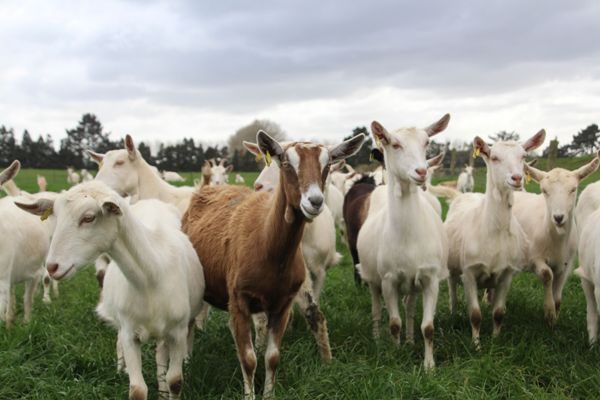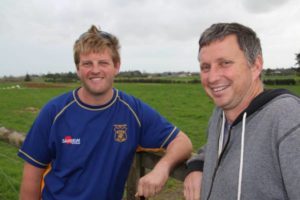Finding a new niche
With a growing demand for alternative and premium milk products, sheep and goat milking is a niche but growing industry. Lynda Gray met two Auckland farmers making the most of it.

Experienced cow and goat dairy farmers James Wallace and John McLaughlin are perfectly placed for sheep milking. Their location, just south of Auckland, is well positioned for easy distribution to both Auckland and Waikato. On top of that is their practical know-how of commercial-scale cow dairying which is being put to good use in developing a hybrid goat and sheep milking system.
On 70ha of lease land at Karaka the pair have developed a milking platform for 300 goats and 670 sheep. A 16-aside herringbone shed for cows was converted for goat milking last year. It was a relatively straightforward process, requiring not much more than changing the cups, pulsation rates, and stall heights. The goat configuration appears to work well for the sheep, the first of which were cupped up on 12 August.
There are four casual employees who help out with milking and feeding; it’s been surprisingly easy to get the staff.
“We’ve found that once people give goat milking a go they don’t want to go back to cows,” James says.
The goal over the next year is to get in place the basics of stock management and feeding to supply goat and sheep milk year-round.
The pair are targeting 45kg/MS (290 litres) per ewe in the first season – that’s the estimated break-even point, James says. But to be commercially viable the ewes will have to produce about 400-plus litres over a season which is typically what animals in established European sheep dairies manage.
The ewes are large and leggy East Friesian with a touch of Awassi. Most of them are from Spring Sheep NZ who have invested heavily in imported European genetics.
The ewes started lambing on 10 August, over six weeks, and some will lamb again in February.
They’re grazed on grass with ad-lib lucerne silage and a 300gm/day supplement of maize, as well as minerals to balance the rumen.
The lambs stay on the ewe for 48 hours and are then taken to a sheltered covered yard area at James’ family farm, a 10 minute drive away. The lambs have ad-lib access to milk from a Lely automated milk feeder. They’ll be gradually introduced to grain and by three months will be weaned onto pasture.
James and John’s goat and sheep dairy diversification started in November last year with the going concern purchase of Wairere Creamery, a goat milking business. The goat diversification appealed for a number of reasons; primarily the opportunity to provide a high-quality milk alternative with health benefits for the elderly and people with lactose sensitivity and allergies. The diversification also stacked up financially with no share capital outlay needed as with cow dairy.
Another compelling reason was that it seemed the right thing to do, given prevailing concerns from some sectors about the environmental footprint of dairy cows, as well as the growing demand for non-dairy and cow milk alternatives.
“I could see how the world was changing so when this opportunity came up I said ‘why not tap into it’,” John says.
At takeover Wairere Creamery had been struggling to meet the year-round supply requirements of the Countdown supermarkets supplied. However, this problem has been solved through management and more goats.
The milking of sheep came into the equation on the realisation that although goat milk ticks the premium quality and health boxes, not everyone likes the taste. The decision was made to test run the milking of 100 ewes, but before long conversations and a relationship with Spring Sheep NZ led to a surge in the sheep herd from 300 then to 670.
This year the milk will be supplied to Spring Sheep NZ from August until early April, some of which will be used for fresh deliveries to supermarket customers of Wairere later in the year. Beyond April, when Spring Sheep will have dried off their milking herds, Wairere will continue to supply a lesser volume of milk so that their supermarket customers will get year-round supply.

Dairy die-hards
James and John have known each other for a number of years, and have gone into business taking on particular roles.
“John’s the big thinker and good with project management side of things whereas I’m responsible more for livestock management and record keeping,” James says.
James has a 20-year track record of milking cows, working up through the ranks from contract milker to 50:50 sharemilker and equity partner in a South Island business Rangitata Dairy. He sold his equity shareholding in 2012 and moved south of Auckland, where he has family connections, to buy a broiler chicken farm. He enjoyed the diversification but had a yearning to get back to dairying.
“I missed the pasture and the milking.”
John was born and raised on a dairy farm at Westport. He moved to Karaka in 2012, establishing an 850 dairy cow milking business on three leased farms in the area. That same land leasing and milking arrangement for cows could also apply to sheep in the future, John says.
The pair recently employed a marketing manager who has the responsibility for relationship management with the growing number of supermarkets in Auckland, and the upper North Island.
James combines the sheep and goat management around the broiler business and family: Stacey, his wife, and kids Karley (13), Ashton (10), and Emilia (2 months). Similarly John and partner Wendy juggle the demands of their kids Taffy (2) and Billy (1) with the cows, goats and sheep. It’s a full-on time for both families but they’re motivated to succeed in the sunrise industry.
“It’s early days and we’re learning as we go but we believe there are lots of opportunities for premium milk products,” James says.




